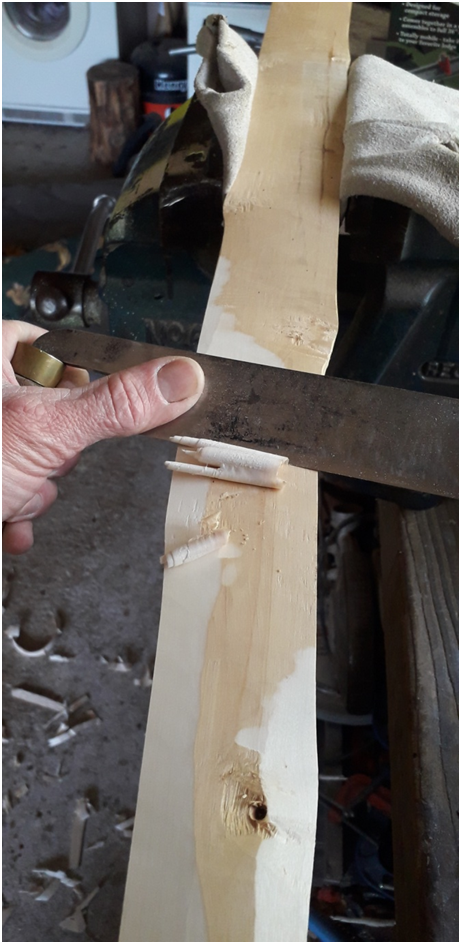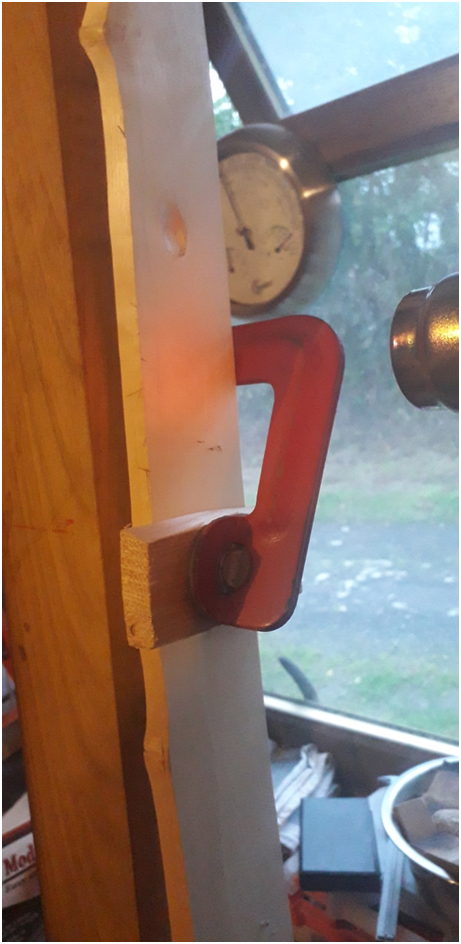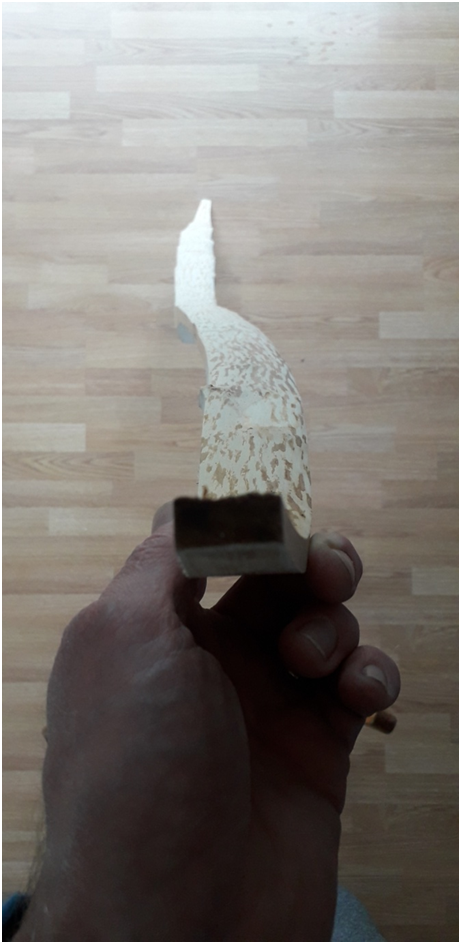This project started out as a simple short term experiment. I’d had my eye on a clean but crooked and twisted Field Maple limb for quite a while. Trying to envisage where within the limb I could salvage a stave from was difficult. The limb was about 4.5” thick and had a section about 80” long which was relatively clean. In general the limb was sound and free from large knots, pins and other major imperfections.
The 80” section that showed most potential for making a bow stave did have other issues to consider however. This most usable section was badly twisted and had a significant sideways bend in one half of the stave. There was also a very large amount of natural reflex in what would be the middle/handle section.
To start with, I just wondered if it would be possible to improve the shape, twist and alignment of such a misshapen stave whilst it was still green. I’ve performed many shape corrections on green staves before, using forms and clamps, but I’d never before tried to correct asymmetries in a stave which were as server as this without using fully seasoned staves manipulated with steam bending.
I’ve worked with clean Field Maple on many occasions before so understand the potential this wood has for making a very good white wood bow. In the past I’ve used dry heat to correct minor twist and alignment issues on fully seasoned Field Maple staves. I’ve also used steam heat bending on Field Maple staves for more significant bending such as recurving tips or bending handles for alignment issues etc.
The amount of twist and reflex in this Field Maple stave however was way more than I’ve dealt with before. My expectations for this stave were not great. I envisaged the stave resisting the significant forces necessary to bend and twist this green stave into a better shape.
I also expected cracking or delamination to occur in the mid section due to the shear amount of force than would be necessary to pull the twist out using clamps and a drying form. But my expectations were proven wrong!


The reflex in the handle section was going to remain no matter what I did but this was fine as I could imagine this stave potentially turning into a reflex/deflex longbow. By leaving the limbs full width out to the tips I was able to get significant leverage from the clamps positioned on the edges of limbs. This leverage enabled me to crush down on the side of the limb that was pulling away from the form due to the limb twist. This worked really well and the twist between the fades and the limb tips came out beautifully.
The overall shape was made much more even by using the reflexed form too. By forcing the tips to line up with the handle centre I was also able to correct most of the significant string misalignment. Throughout the end of August I left the clamped stave outside in the sun on hot days.
The stave came indoors for a week once the temps dropped and was left on one of my window sills which catches all of the mid day sun. This window sill is like a green house and serves to quickly force dry staves very well. After the stave had been allowed to dry on the form for about a month I removed the clamps to inspect the results.


The overall twist was reduced from nearly 70 degrees to about 5 degrees. The massive reflex was tamed to something much more manageable and the string alignment was now only a little off to one side. The stave now actually looked perfectly workable with plenty of character remaining, so instead of calling the project done I decided to see what I could do to turn this stave into an actual finished bow.
My next job was to get this stave down to some realistic dimensions. It would be unlikely that this stave was totally dry so by getting close to final dimensions I’d soon get this stave fully dried and ready for tillering.







Field Maple is a dense wood so these 14+mm thick limbs will need quite a bit of reducing in order to get them to a point where the tillering process can begin. I’m going to aim for 14mm fade end thickness tapering down to 10mm side thickness at the tips. I want the tips to do a very small amount of work on this bow so I will reduce them down to 10 mm but keep away from them when tillering. This should Keep the last 6” of the tips stiffer than the working section of the limb, but without leaving the tips carrying unnecessary mass which would be the consequence of keeping the tips thick enough to ensure that they are completely static.










When I work the face down to rough dimensions on any bow, I always let the grain dictate the limb shape. This avoids creating grain run out which in my experience is a fast way to limb failure.

Until the cambium has been thinned right down I can’t get a true handle on the real thickness of all parts of the limb. I tend to leave quite a lot of cambium on a stave right through to the limb thickness reduction phase as the cambium layer acts as a good layer of protection to the back of the bow. A cushion against scrapes and scratches is a good idea whenever the back of a bow will be seen on the finished bow. Since this bow will not be backed the natural appearance of the first layer of wood below the cambium will be displayed on the finished bow so taking care to protect the back of this stave is important.


Personally I like the appearance of self bows which have a little bit of cambium left on the back of the bow. This little bit of cambium adds to the beauty of the finished bow and confirms to the observer that the back of the bow is in actual fact the very wood which once grew directly beneath the bark. No ring chasing necessary. This remaining cambium also creates a beautiful camouflaged effect on the back of the bow.

As tempting as it often is to hog at the cambium with a draw knife it is too easy to nick the underlying wood and compromise the back of the bow so I always proceed with caution using a scraper for raised spots in particular.

The back of this stave has an undulating topography which presents as hills, valleys and troughs. If I were to leave the belly completely flat in cross section then the hills on the back would act as stiff points and the valleys and troughs would act as weak spots. To counter this potential problem I contour the bellies on my wide limb bows so that the belly topography matches that of the back but in reverse. To achieve this I use a mixture of gouges and curved scrapers to remove material from the belly directly opposite the hilly thicker spots on the back. This enables me to leave material behind over the thinner valley and trough areas of the back. This affords them extra protection and creates a truly even thickness across the entire width of the limb.

I use my fingers to feel the thickness across the whole limb. If I find a thick spot I’ll remove material from the belly until the thickness is the same as everywhere else nearby. I’m aiming to end up with limbs which are an even taper of 14mm – 10mm thick along the entire length and width of the bow. This means that areas of the back which present as high crowned will have a corresponding belly section which is effectively hollowed out to counter for the crowned back. This stave has a mixture of high crown plus flatter sections with hills, valleys and troughs so the belly will end up being far from flat.







The next job was to put some deflex into the limbs to counter for the reflex in the handle section. I do this with the flat back of a form and some padded blocks and a clamp to create the right shape. I’m aiming to create most of the deflex around the first third of the limb about 6 – 12” out from the ends of the fades.




I’m carful where I choose to heat as I want to flick the tips on this stave and realise that if I make an early heat correction to a limb near the tips then the steaming of the tips which takes place later will pull the previous heat correction back out when the heat from the steaming travels down to where the twist correction was made.

I’m a fan of longbows but enjoy the lack of stack which a recurve benefits from. Whilst not wanting to go for a full recurve design on this bow I did like the idea of balancing the deflex and reducing stack a little by flicking the tips on what is aimed at finishing up a longbow.

After half an hour over the pan I fit my steel ruler to the belly of the stave using a small G clamp and a packing block to protect the back from clamping pressure. I frequently do this as it really helps prevent the belly tips from delaminating when being bent over the recurve form. The extra support of the flexible steel ruler simply stops a splinter lifting on the belly which is the kiss of death to many would be bows. This trick is especially important if your stave tip belly is not presenting as one growth ring, which is the case here. On this particular stave, both tips span two growth rings so delamination is a high probability without the ruler acting as a brace.







I have to be careful at this point to make sure that the deflex that has already been put in is not lost. I make sure to protect the deflex by setting up the paddle so that the leverage is the direction that promotes flexion to the limb rather than extension. This trick will ensure that the deflex is preserved.

I thought about including an arrow shelf on this bow and certainly had plenty of wood left with which to do that, but I fancied going old school and figured a simple handle for off the knuckle shooting would complement the natural lines of this stave best.





For a detailed description of how I added deer antler tip overlays to this stave see this separate article Here: https://southmoorbows.com/4-secrets-to-making-your-best-antler-bow-tip-overlays/




The depth of heat penetration that you get with this method is significantly greater than can be achieved with a heat gun. After 45 minutes the handle section is scolding hot so the stave is manipulated into alignments and then comes off the heat and is allowed to cool for an hour. After the jig comes off I check for alignment and am happy to see that the correction has brought string alignment back to just favouring the left side which is perfect for a right handed archer such as me.


This stave is heavy but almost braceable right out the gate. After about 15 mins of long string tillering on the tiller tree the bow can be strung at a 6” brace height.
The left limb in the picture above is the bottom limb and is slightly weaker than the right limb which the top limb. I shoot split fingers so want this bow to finish out with an 1/8″ – 1/4 ” positive tiller. This was opposite to what the bow was doing at brace so I needed to reduce to top limb to swing the balance the other way. This is fine though as at this point, the bow is still quite heavy. I’m a short drawer so I’m aiming for 50lbs at 26”. At the minute I’m still getting 50lb at 22” so I spend an hour carefully reducing the weight of the top limb and tickling away at any stiff spots overall.

I’ve now got the stave down to 53lb at 26″ on the tillering tree. The extra 3lbs will likely come off as the bow is fine tillered and sanded after being shot in. both strung and unstrung I’ve got a really nice even balance of reflex in the handle and tips combined with a nice bit of mid limb deflex. The flicked tips haven’t pulled out and the string alignment is still just slightly biased towards the left side of the bow which for me as a right handed shooter is perfect. No signs of chrysaling anywhere on the belly and no splinters to be seen on the back. Time to get a handle wrap on and shoot her in.

I always shoot a couple of hundred arrows through all of my unfinished bows before sanding and finishing. I’ve learnt that a bow which has been meticulously tillered on the tillering tree will move considerably through actual shooting. After two hundred shot you know what you have. I then recheck my tiller and adjust accordingly.




The finished bow can be seen here: https://southmoorbows.com/character-field-maple-deflex-reflex-selfbow-50-26/
Until next time!
